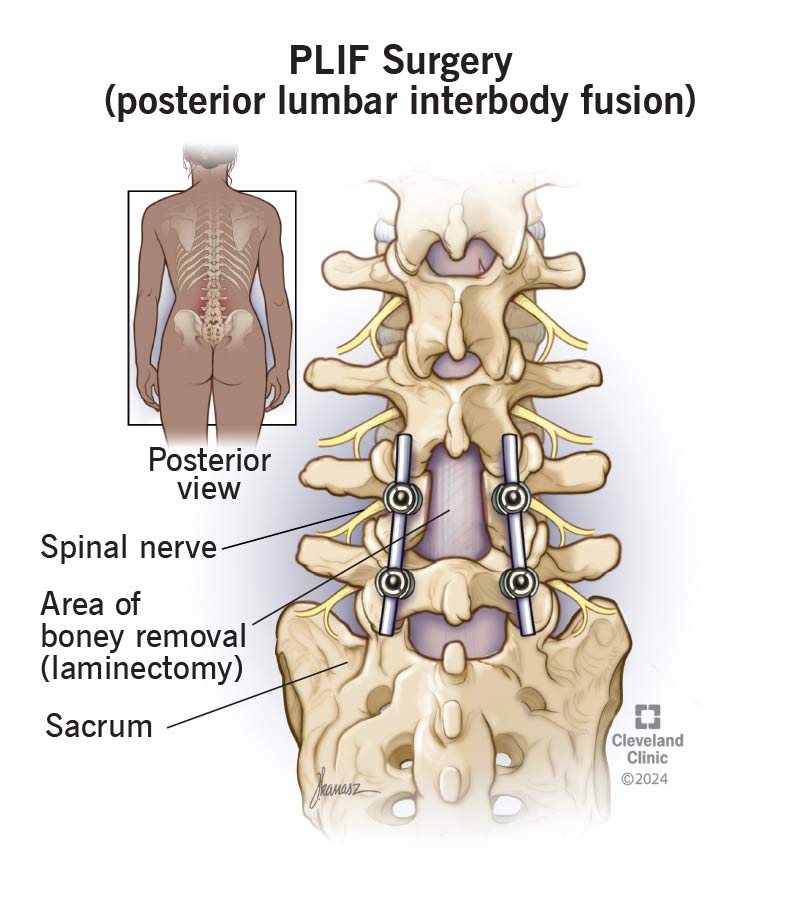PLIF (posterior lumbar interbody fusion) surgery treats lower back pain. Surgeons do PLIF to relieve severe leg and lower back pain that happens when intervertebral disks put pressure on your spinal nerves. In PLIF, surgeons replace damaged disks with bone grafts. The bone grafts create new bone that helps fuse or join your vertebrae.
Advertisement
Cleveland Clinic is a non-profit academic medical center. Advertising on our site helps support our mission. We do not endorse non-Cleveland Clinic products or services. Policy

Posterior lumbar interbody fusion (PLIF) surgery is a type of spinal fusion. PLIF is treatment for leg pain and lower back pain that happens when intervertebral disks — the soft round disks that separate your vertebrae — are damaged or wear out. These disks put pressure on your spinal nerve and cause leg or lower back pain.
Advertisement
Cleveland Clinic is a non-profit academic medical center. Advertising on our site helps support our mission. We do not endorse non-Cleveland Clinic products or services. Policy
In PLIF, spine surgeons remove the damaged disk and insert interbody spacers (devices) made of metal, plastic or bone. The devices are the same height as the damaged disk, so they fill the open space between your vertebrae.
Healthcare providers typically use PLIF to treat:
PLIF is a common treatment for chronic leg pain. It may be a treatment for lower back pain. Typically, PLIF and other lumbar surgery happen when pain management, physical therapy or other nonsurgical treatments don’t provide significant relief. Surgeons may do PLIF as open surgery — when surgeons make a single long incision through your skin — or as minimally invasive spine surgery.
Before surgery, your care team will ask you questions to confirm you’re a good candidate for the operation. They’ll ask about your medical history, including any earlier back surgeries. Your team may:
Advertisement
You should:
You should:
At the hospital, you’ll meet with your anesthesiologist. They’ll explain the type of anesthesia you’ll receive and what to expect as you recover from anesthesia.
A healthcare provider will take you to the operating room. You’ll need to lie face down (prone) for surgery, and your care team will help you get into position before you receive anesthesia.
During PLIF, your spine surgeon will:
In general, PLIF surgery takes two to three hours.
Your care team will move you to a recovery area, where you’ll rest while you recover from anesthesia. Your recovery room team will regularly check your pulse, breathing and other vital signs and give you medication for pain.
You’ll move to another room in the hospital to continue recovering from your surgery. Your surgical team will check for complications like infections. You may need to spend a day or two in the hospital.
PLIF is one of several types of lumbar interbody fusion. Other types are anterior lumbar interbody fusion (ALIF), lateral lumbar interbody fusion and T-lumbar interbody fusion (TLIF).
If you’re considering spine fusion surgery, your spine surgeon will recommend the surgical choice that’s right for your situation.
Like most surgeries, PLIF complications may include risk of infection and excessive blood loss. Other potential complications include:
It could take a full year before you completely recover from surgery as your bone graft fills in the disk space and fuses your vertebrae. Your provider will give you detailed instructions on activities you can do and activities you should avoid as you recover.
Advertisement
It may be a relief not to have back pain. You may be eager to get back to your daily activities. Try to be patient and give your body time to recover. For example, you can (and should) take short walks every day. But it could be several weeks before you’re able to do things like bend, twist, lift objects or drive without pain. Here’s what you can expect:
First two to four weeks
You should avoid:
Four to six weeks
You should avoid:
You should contact your provider if you have:
Advertisement
If you’re considering PLIF (posterior lumbar interbody fusion) surgery, pain is likely affecting your quality of life. The good news is that PLIF is proven treatment for severe leg pain and lower back pain. Even so, you may feel anxious about having back surgery. Your healthcare team knows this is a big decision. It’s OK to have lots of questions. Your team will be glad to explain how PLIF works and what you can expect as you recover.
Advertisement
When you have robotic and minimally invasive spine surgery at Cleveland Clinic, it’s possible to have a faster recovery, less pain and smaller scars.

Last reviewed on 11/15/2023.
Learn more about the Health Library and our editorial process.